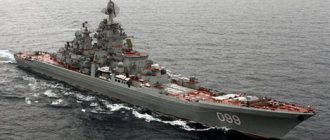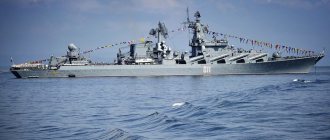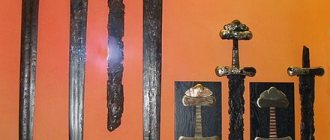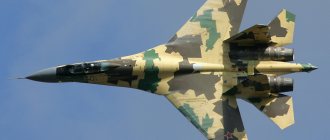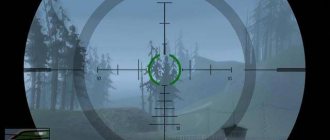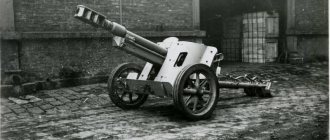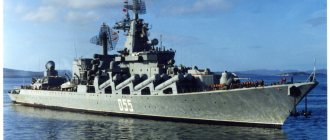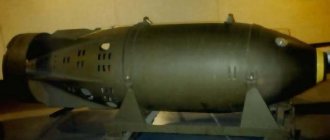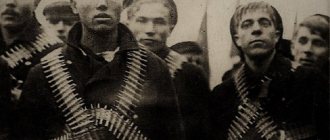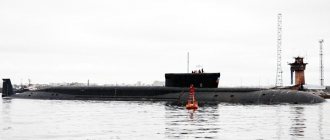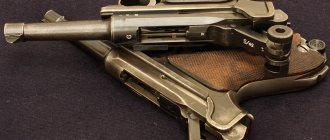The cruiser Varyag, which entered into an unequal battle with much superior enemy forces, wrote its heroic page in the history of the Russian-Japanese War. His feat, as well as the feat of the “Korean,” will forever remain in the hearts of people.
Russian sailors withstood an unequal battle with the Japanese, did not surrender to the enemy, sank their ship and did not lower the flag. This legendary battle with six enemy cruiser ships and eight destroyers made an indelible impression not only in Russia, but also abroad. We’ll talk about the history of the cruiser “Varyag” today.
Background
Considering the history of the cruiser "Varyag", it would be advisable to turn to the events that preceded it. The Russian-Japanese War (1904 – 1905) was fought between the two empires for control of the territories of Manchuria, Korea, and the Yellow Sea. After a long break, it became the first major military conflict in which the latest weapons such as long-range artillery, battleships and destroyers were used.
The issue of the Far East at that time was in first place for Nicholas II. The main obstacle to Russian dominance in this region was Japan. Nicholas foresaw the inevitable clash with her and prepared for it from both the diplomatic and military sides.
But there was still hope in the government that Japan, fearing Russia, would refrain from a direct attack. However, on the night of January 27, 1904, without a declaration of war, the Japanese fleet unexpectedly attacked the Russian squadron near Port Arthur. There was a naval base here that Russia leased from China.
As a result, several of the strongest ships belonging to the Russian squadron were out of action, which ensured that the Japanese military landed in Korea in February without any obstacles.
Cruiser Akashi
This ship did not take a noticeable part in the battle of Chemulpo. Due to its location, during the entire battle with the Varyag, only two 152-mm shells were fired from the Akashi, and the cruiser, along with the destroyers, largely played the role of an extra.
Cruiser Akashi. Source: a0z.ru
True, the ship was later actively used during the siege of Port Arthur, supporting the actions of Japanese troops. On the night of November 27, 1904, the Akashi was blown up by a Russian mine and almost died. The ship was expelled from the fleet in 1923, and seven years later it was sunk during an aviation exercise.
Attitude in society
The news that war had begun left no one in Russia indifferent. At its first stage, the prevailing mood among the people was a patriotic mood, an awareness of the need to repel the aggressor.
Unprecedented demonstrations took place in the capital, as well as in other big cities. Even revolutionary-minded youth joined this movement, singing the anthem “God Save the Tsar!” Some opposition circles decided to suspend their actions during the war and not put forward demands to the government.
Before moving on to the story of the feat of the cruiser "Varyag", let's talk about the history of its construction and characteristics.
Under the Japanese flag
In the pre-Internet era, perhaps only archivists knew that its story had not yet ended with the sinking of the Varyag. In the place where it was flooded, the depth was not too great, so diving work could be carried out. And the level of development of technology at the beginning of the 20th century was quite enough for the Japanese to be able to lift the Varyag from the abyss within a year. Imagine their amazement when they realized that the Japanese squadron had been successfully opposed by a faulty ship!
First of all, the Japanese replaced the steam boilers on the Varyag. And then they patched it up at a shipyard in Sasebo, Japan, and introduced it into the Japanese Navy. The captured ship received a new name "Soya". It became a training ship on which sailors and future officers were trained, and in this capacity the cruiser repeatedly made long sea voyages in the Pacific Ocean. He served under the Japanese flag for seven years, and then spent another three years in the reserves.
Construction and testing
The ship was laid down in 1898 and built in the United States, in Philadelphia. In 1900, the armored cruiser Varyag was transferred to the Russian Navy, and since 1901 it has been in service. Ships of this type were common at the turn of the 19th and 20th centuries. Their mechanisms, as well as gun magazines, were protected by an armored deck - flat or convex.
This deck was the ceiling of the ship's hull, located horizontally in the form of a flooring made of armor plates. It was intended to protect against bombs, shells, debris and shrapnel falling from above. Ships such as the armored cruiser Varyag constituted the largest part of the cruising fleet of most maritime powers at the turn of the century.
The ship's base was Port Arthur. Although some researchers claimed that it had poor boiler design and other construction defects that resulted in a significant reduction in speed, tests showed otherwise. In tests carried out in 1903, the ship achieved high speed, almost equal to the speed of the original tests. The boilers served well for many years on other ships.
Modernization and refurbishment
The Varyag missile cruiser underwent modernization under Project 58M in 1976-1980. Project 58M is a variant of the modernization of Project 58 ships with increased missile, anti-aircraft and radio-technical weapons.
Automatic ship artillery mount AK-630
The technical project included the modernization of the P-35 complex for the improved 3M44 Progress missile, the modernization of the M-1 Volna complex, the installation of four short-range AK-630 with 2 MR-123 Vympel control systems, a second Don navigation radar and the latest radar, identification and electronic warfare equipment.
The cruiser's hull has undergone alterations. The configuration of the bow superstructure has changed significantly due to the installation of 4 six-barreled 30-mm AK-630M artillery mounts, two on each side, and 2 radars for controlling their firing. In the area between the masts, on the forecastle deck, a new small superstructure was created to accommodate the long-distance communication system. It also housed two 45-mm salute cannons, which were previously located on rostra near the mainmast. Where previously there were 45-mm salute cannons, closed rooms were installed to house the equipment of the Uspeh-U data reception and target designation system from helicopters and aircraft, which was used for radar guidance of 3M44 Progress ship-based cruise missiles.
4 six-barreled 30-mm AK-630M assault rifles with a barrel length of 54 calibers, located in pairs, side by side on banquets near the first chimney, were supposed to provide defense against anti-ship missiles that appeared in the arsenal of NATO fleets in the 1970s. The AK-630 is a turret-type artillery mount with a rotating block of barrels in a casing with a longitudinal piston bolt, which ensures forced firing of the shot and extraction of the cartridge case. The rate of fire of the installations is 4000-5000 rounds per minute. The barrel block is cooled by passing distilled water or antifreeze between the casing and the barrels. The vertical guidance angle is from −12 to +88°, and the horizontal guidance is up to 180°. The initial projectile speed is 960 m/s, the firing range is up to 8.1 km. The machine guns are powered by a belt; the 2,000-round belt is located in a round magazine. The crew of the gun includes 2 people. The weight of the installation is 1.92 tons. The assault rifles have a remote control system from 2 MP-123 Vympel radars or using an autonomous Kolonka sighting device.
State of war
In 1904, at the beginning of February, two ships from Russia arrived at the port of Seoul, the capital of Korea, on a diplomatic mission. These were the cruiser "Varyag" and "Koreets", a gunboat.
Japanese Admiral Uriu sent a notice to the Russians that Japan and Russia were at war. The cruiser was commanded by Rudnev V.F., captain of the 1st rank, and the boat was commanded by captain of the second rank G.P. Belyaev.
The admiral demanded that the Varyag leave the port, otherwise the battle would be fought right in the roadstead. Both ships weighed anchor, and a few minutes later they gave a combat alert. In order to break through the Japanese blockade, Russian sailors had to fight through the narrow channel and go out into the open sea.
This task was almost impossible. The Japanese cruisers conveyed a proposal to surrender to the mercy of the winner. But this signal was ignored by the Russians. The enemy squadron opened fire.
Damage received during the battle and human losses[17]
During the battle, the cruiser "Varyag" received the following damage:
- rangefinder station No. 1 was broken;
- 6-inch guns No. 3, IX, XII, 75-mm gun No. 21, 47-mm guns No. 27 and No. 28 were knocked out;
- rangefinder station No. 2 was destroyed;
- guns No. 31 and No. 32 were knocked out;
- all 47-mm guns became unusable;
- five 6-inch guns damaged;
- seven 75 mm guns were damaged in their mounts and compressors;
- the pipe in which all the steering drives pass is broken;
- the battle mainsail was almost demolished;
- 4 underwater holes were found;
- the upper bend of the third chimney was destroyed;
- all fans are broken;
- the command room was destroyed;
- numerous minor damages.
Human losses:
- Rangefinder officer midshipman Count Nirod and 38 lower ranks were killed;
- 3 officers were wounded (severely - midshipman Gubonin, lightly - midshipmen Laboda and Balk) and 70 lower ranks;
- Commander Captain 1st Rank Rudnev was shell-shocked and wounded in the head.
Therefore, at a general meeting of the cruiser’s officers, it was decided to scuttle the ship so that it would not fall into the hands of the enemy.
"Varyag" after the battle
After the evacuation of the crew to ships of neutral countries, the Varyag was flooded on February 9 (new style) at 18:10: the senior and bilge mechanics, together with the owners of the compartments, opened the valves and seacock. "Korean" is blown up. The Russian steamship Sungari was also sunk[18][19][20].
After the Russo-Japanese War, the Japanese government created a museum in Seoul in memory of the heroes of “Varyag”[21] and awarded Rudnev the Order of the Rising Sun[22].
Fierce fight
The battle of the cruiser "Varyag" with the Japanese was brutal. Despite the hurricane attack, which was carried out by ships, one of which was classified as heavy, and the other five as light (and also eight destroyers), Russian officers and sailors fired at the enemy, filled holes and extinguished the fire. The commander of the cruiser "Varyag" Rudnev, despite being wounded and shell-shocked, did not stop leading the battle.
Ignoring great destruction and heavy fire, the Varyag crew did not stop aimed fire from those guns that were still intact. At the same time, “Korean” did not lag behind him.
As stated in Rudnev’s report, the Russians sank 1 destroyer and damaged 4 Japanese cruisers. The losses of the Varyag crew in the battle were as follows:
- The following were killed: officers - 1, sailors - 30.
- Among those who were wounded or shell-shocked, there were 6 officers and 85 sailors.
- Approximately 100 more people were slightly injured.
The critical damage inflicted on the cruiser "Varyag" forced it to return to the bay roadstead one hour later. After the extent of the damage had been done, those guns and equipment that remained after the battle were, if possible, destroyed. The ship itself was sunk in the bay. The “Korean” did not suffer any casualties, but was blown up by its crew.
Next, we will take a closer look at how this battle took place, which led to the death of the cruiser “Varyag”.
"Varyag" in the Far East
In the fall of 1901, the cruiser set off on a long voyage along the route St. Petersburg - Cherbourg - Cadiz - Algiers - Palermo - Crete - Suez Canal - Aden - Persian Gulf - Karachi - Colombo - Singapore - Nagasaki - Port Arthur. The technical imperfections in the cruiser’s design began to affect the transition. The boilers, the installation of which was so controversial, allowed the ship to travel at low speed. Only for a short time could the Varyag move at 20 knots (subsequent attempts, already in the Far East, to correct the situation led to a further decrease in speed. At the time of the battle in Chemulpo, the ship could not move faster than 16 knots).
Having made a significant number of calls to foreign ports, circumnavigating Europe and Asia, on February 25, 1902, the Varyag arrived at the Port Arthur roadstead. Here the cruiser was examined by the head of the Pacific Squadron, Vice Admiral N.I. Skrydlov and the commander of the naval forces of the Pacific Ocean, Admiral E.I. Alekseev. The ship became part of the Pacific Ocean squadron and began intense combat training.
In her first year of service in the Pacific alone, the cruiser covered nearly 8,000 nautical miles, conducting approximately 30 gunnery training exercises, 48 torpedo firing exercises, and numerous mine-laying and net-laying exercises.
However, all this was not “thanks to”, but “in spite of”. The commission, which assessed the technical condition of the ship, gave it a serious diagnosis: “The cruiser will not be able to reach a speed above 20 knots without the risk of severe damage to the boilers and machinery.”
Vice Admiral N.I. Skrydlov described the technical condition of the ship and the efforts of its crew as follows: “The stoic behavior of the crew is commendable. But the youth would not have had to mobilize all their strength to overcome a simple curriculum if the damned fate in the person of one American had not put them in such conditions with its incompetence in matters of engineering.”
The cruiser "Varyag" and the squadron battleship "Poltava" in the Western basin of Port Arthur. November 21, 1902. Photo by A. Diness. Photo: https://encyclopedia.mil.ru/encyclopedia/history/ licensed under Creative Commons Attribution
Captain V.F. Rudnev. Photo: Portal “Old Vladivostok”
Under the leadership of a talented commander, the cruiser continued to participate in the activities of the fleet. During artillery firing V.F. Rudnev discovered that almost a quarter of large-caliber shells do not explode. He reported this to the command, and achieved a complete replacement of ammunition. But the results of the shooting remained the same.
The cruiser continued to serve regularly as part of the Pacific Ocean Squadron. Frequent accidents of the Varyag's vehicles, as well as its low speed, forced the cruiser to be sent to the Korean port of Chemulpo as a stationary. In order not to once again overload the cruiser’s vehicles, the gunboat “Korean” was assigned to it as a courier.
Gunboat "Korean". Photo: Portal “Old Vladivostok”
In addition to the Varyag, ships from other countries were stationed in Chemulpo: England, the USA, France, Italy and Japan. The latter, almost without hiding, was preparing for war. Its ships were repainted in camouflage white, and its coastal garrisons were significantly strengthened. The port of Chemulpo was flooded with many vessels prepared for landing, and thousands of Japanese walked the streets of the city, masquerading as the local population. Captain 1st Rank V.F. Rudnev reported that the start of hostilities was approaching, but in response he received assurances that all this was just a demonstration by the Japanese of their strength. Realizing that war was inevitable, he conducted intense training with the crew. When the Japanese cruiser Chiyoda left the port of Chemulpo, Captain 1st Rank V.F. It became obvious to Rudnev that the start of hostilities was a matter of days, if not hours.
Battle of Chemulpo, beginning
In the roadstead near the Korean city of Chemulpo (now Incheon) there were ships of the Italians, British, Koreans, as well as Russian ships - “Varyag” and “Koreets”. The Japanese cruiser Chiyoda was also moored there. The latter, on February 7, at night, left the roadstead without turning on the identification lights and set off for the open sea.
At about 16:00 on February 8, the “Korean”, leaving the bay, met with a Japanese squadron, which consisted of 8 destroyers and 7 cruisers.
One of the cruisers, called "Asama", blocked the path of our gunboat. At the same time, the destroyers fired 3 torpedoes at her, 2 of which flew past, and the third sank a few meters from the side of the Russian boat. Captain Belyaev gave the command to go to a neutral harbor and hide in Chemulpo.
Service
The cruiser Varyag set off on its first voyage from the port of Philadelphia on March 20, 1901. He had to cross the Atlantic Ocean and get to Kronstadt, the main base of the Baltic Fleet. The length of this route was 5083 miles. At first, this passage went quite safely, despite the strong wind and significant waves - the ship’s seaworthiness turned out to be almost impeccable.
However, it soon became clear that coal consumption slightly exceeded the established standards. Because of this, the cruiser was forced to make an unscheduled stop in the Azores, staying there for five days due to a strong storm. The next point on the route was Cherbourg. In this port, the French engineer Nikloss, the inventor of the boilers installed on the ship, boarded the Varyag. He, like the British Parliament commission that arrived on the same day, was interested in the condition of this equipment after a long journey across the ocean.
The checks did not reveal any malfunctions, but the Varyag team still overhauled the main mechanisms and only then the ship continued its journey. He arrived in Kronstadt on May 3.
Photo taken during sea trials of the Varyag in the Atlantic Ocean
On August 5 of the same 1901, “Varyag” set off for its place of service, in the Far East. At the first stage of this passage, the cruiser accompanied the yacht "Standart", on board of which was Nicholas II. On September 16, the ship left the last European port of Cherbourg on the route and headed for the Mediterranean Sea, from where it proceeded through the Suez Canal to the Indian Ocean. During this voyage, boilers of a new design for the Russian fleet truly “reminded themselves” for the first time. During each stop they had to be repaired. After arriving in Port Arthur at the end of February 1902, the cruiser’s power plant was studied by a commission specially created for this purpose, which came to the conclusion that the Varyag could not reach a speed of more than 20 knots, and over long distances it was necessary to limit it to sixteen knots.
Throughout March and April 1902, the Varyag was undergoing repairs. The team conducted exercises without going to sea. In May, the ship set off on a “cruising” voyage, during which the Varyag moved mainly along the shores of the Kwantung Peninsula.
In August 1902, the boilers had to be repaired again. The repair took about two months. Then a short trip to Korea was made, after which the ship remained at the quay wall until April of the following year.
After two short transitions in the spring of 1903, the Varyag again found itself in the armed reserve. The reason was both regular breakdowns and a planned “rotation” of the crew. By October 1903, it became clear that it was impossible to completely repair the Varyag at the place of its permanent service - this required a dry dock.
View of the forecastle of the cruiser "Varyag"
O. V. Stark (at that time he headed the Pacific Fleet) sent a report to the Main Headquarters of the Navy, in which he proposed sending the Varyag to Kronstadt for subsequent major repairs. This initiative did not receive support. Representatives of the Maritime Ministry considered that the cruiser should serve for at least one more year. True, at the same time a number of parts were sent to Vladivostok to repair the power plant, but this “parcel” did not have time to reach the recipient by the beginning of the war of 1904-1905.
About two months before the Japanese attack, the ship, due to its limited combat capability (the maximum speed had to be reduced to 17 knots), was “switched” to carry out diplomatic missions. During one of them, the Varyag ended up in the port of Chemulpo (he had previously made short visits there). Next to him in the roadstead was another small Russian ship, the Koreets, which was a slow-moving gunboat with outdated weapons.
Developments
Studying the history of the cruiser "Varyag", we will give a detailed picture of the events of February 9 hour by hour:
- 7.30. As mentioned above, the commander of the Japanese squadron, Uriu, sends a telegram to the ships stationed in the bay about the state of war between the Russians and the Japanese, where it was indicated that he would be forced to attack the neutral bay at 16 o’clock if the Russians did not appear on the open sea by 12 o’clock.
- 9.30. Rudnev, who was on board the British ship Talbot, became aware of the telegram. Here a short meeting takes place and a decision is made to leave the bay and give battle to the Japanese.
- 11.20. "Korean" and "Varyag" go to sea. At the same time, on the ships of foreign powers that observed neutrality, their teams were lined up, who greeted the Russians going to certain death with cries of “Hurray!”
- 11.30. The Japanese cruisers were in battle formation off Ritchie Island, covering the exits to the sea, with destroyers behind them. "Chiyoda" and "Asama" began the movement towards the Russians, followed by "Niitaka" and "Naniwa". Uriu proposed to the Russians to surrender and was refused.
- 11.47. As a result of precise attacks by the Japanese, the deck on the Varyag is on fire, but it can be extinguished. Some of the guns were damaged, there were wounded and killed. Rudnev was shell-shocked and seriously wounded in the back. Coxswain Snigirev remains in service.
- 12.05. The steering mechanisms on the Varyag are damaged. A decision is made to turn back completely, without ceasing fire on enemy ships. The Asama's aft turret and bridge were disabled and repair work began. The guns on two more cruisers were damaged, and one destroyer was sunk. The Japanese had 30 killed.
- 12.20. The Varyag has two holes. A decision is made to return to Chemulpo Bay, repair the damage and continue the battle.
- 12.45. Hopes for fixing most of the ship's guns are not justified.
- 18.05. By decision of the crew and captain, the Russian cruiser Varyag was sunk. The gunboat, being damaged by explosions, was also sunk.
Cruiser officers and officials
- Commanders: 01/02/1901-03/01/1903 - captain 1st rank Behr, Vladimir Iosifovich
- 03/01/1903-01/27/1904 - captain 1st rank Rudnev, Vsevolod Fedorovich
- 01/02/1902-10/24/1902 - lieutenant (from 12/06/1901 captain of the 2nd rank) Kraft, Evgeniy Karlovich
- 01/02/1901-01/29/1903 - Lieutenant Dolgoborodov, Sergei Stepanovich (transferred to the destroyer "Besposhchadny")
- 08/29/1901-03/21/1902 - Lieutenant Berling, Robert Ivanovich (transferred from the cruiser Svetlana, and then to the squadron battleship Sevastopol)
- 01/02/1901-03/10/1901 - captain of the KMA Petrov, Vladimir Ivanovich
- 01/02/1901-06/05/1901 - Lieutenant Richter, Otton Ottonovich
- 01/02/1901-12/11/1902 - Lieutenant Sverbeev, Sergei Dmitrievich (transferred to the squadron battleship "Petropavlovsk")
- 01/02/1901-06/01/1901 - midshipman Ekimov, Anatoly Petrovich (transferred to watch commander)
- 01/02/1901-06/28/1901 - Lieutenant Nazimov, Ivan Ivanovich (transferred to the cruiser "Admiral General")
- 01/02/1901-01/27/1904 - assistant to senior mechanical engineer Leikov, Nikolai Genrikhovich
- 01/02/1901-07/01/1901 - junior mechanical engineer Rodnin, Vladimir Nikolaevich (transferred to mine mechanics)
- 07/01/1901-06/11/1902 - junior mechanical engineer Rodnin, Vladimir Nikolaevich (transferred from junior ship mechanics, and then to the port ship "Silach"
- 01/02/1901-01/27/1904 - junior mechanical engineer Soldatov, Yakov Savvich
- 01/02/1901-05/21/1903 - collegiate adviser Zort, August Augustovich
- 01/02/1901-06/17/1901 - doctor (from 01/25/1901 collegiate assessor) Zhuk, Alexander Alexandrovich
- 01/02/1901-xx.xx.1902 - titular councilor Ladanov, Konstantin Mikhailovich
- 01/02/1901-01/27/1904 - collegiate secretary Denisov, Andrey Filimonovich
- 01/02/1901-01/27/1904 - titular councilor Markelov, Fedor Andrianovich
- 01/02/1901-10/06/1902 - hieromonk Fr. Vassian
Captain Rudnev's report
It seems that it will be interesting to familiarize yourself with the content of excerpts from Rudnev’s report, the meaning of which boils down to the following:
- The first shot was fired from the cruiser Asama with an 8-inch gun. It was followed by fire from the entire squadron.
- After the zeroing was carried out, they opened fire on the Asama from a distance of 45 cables. One of the first Japanese shells destroyed the upper bridge and started a fire in the navigator's room. At the same time, the rangefinder officer Count Nirod, a midshipman, as well as the rest of the rangefinders of the 1st station were killed. After the battle, they found the count's hand, which was holding a rangefinder.
- After inspecting the cruiser "Varyag", making sure that it was impossible to engage in battle, at a meeting of officers they decided to sink it. The remaining crew and the wounded were taken to foreign ships, which expressed full consent in response to the request.
- The Japanese suffered great casualties and there were accidents on ships. The Asama, which went into dock, was especially badly damaged. The cruiser Takachiho also suffered a hole. He took on board 200 wounded, but on the way to Sasebo his patches burst, his bulkheads broke, and he sank at sea, while the destroyer did in battle.
In conclusion, the captain considered it his duty to report that the ships of the naval detachment, which was entrusted to him, had exhausted all possible means for a breakthrough, prevented the Japanese from gaining victory, inflicted many losses on the enemy, while maintaining the honor of the Russian flag with dignity. Therefore, he petitioned for the team to be rewarded for the valiant performance of duty and the selfless courage shown at the same time.
History of the ship
In 1897, the government of the Russian Empire approved a number of additions to the main program for the construction of the navy. The reason for this decision was the growing activity of Japan. For a long time it was underestimated, considered backward and weak, but over time it became impossible to ignore the rapid increase in Japanese military potential. Of particular concern was the ever-increasing number of modern warships. It was quite obvious that in the coming years Japan would become the owner of the most powerful fleet in the Far East.
As part of the implementation of the updated shipbuilding program, Russia in 1898 entered into a contract with the American one. This agreement provided for the construction of a new armored cruiser, the displacement of which was to be six thousand tons. In the original version of the contract, no other requirements for the future ship were established.
It can be said that this more than strange “technical specification” alone later became one of the reasons for the death of the Varyag. The contract determined only the construction time of the cruiser (20 months) and the cost of the work - about four and a half million rubles.
Armored cruiser "Diana", which was initially considered as a possible prototype for the "Varyag"
The agreement, in addition, indicated that the specification of the ship would have to be precisely determined during its manufacture at the plant - based on the results of consultations between the customer and the contractor.
Charles Crump did not miss the opportunity to take advantage of such a free format of the agreement. When a Russian commission headed by Captain First Rank A.A. arrived in the United States in July 1898. Danilevsky, it immediately became clear that the “American side” was not inclined to listen to the customer’s requests. In particular, Crump insisted on increasing the design displacement of the ship and increasing the power of the power plant.
https://youtube.com/watch?v=9ykGVZKXDJ8
These “whims”, among other things, were indulged by the naval attache of the Russian Empire D.F. Mertvago - despite the fact that he was always in Washington, and the cruiser was being built at the shipyards in Philadelphia (in addition, a squadron was also laid down there armadillo). If something similar happened today, journalists would probably already be talking about “kickbacks” in favor of high-ranking officials.
Further disagreements between the Russian commission and Charles Crump occurred on the following main issues:
- Maximum design speed. The commission insisted that it should be 23 knots, which seemed to Crump an excessive requirement;
- The appearance of the ship. The Americans wanted to make the Varyag similar to the Japanese Kasagi, while in Russia they would have preferred to get a cruiser built on the model of the Diana (that is, the same type as the Aurora, known to everyone today);
- Composition of weapons. The commission insisted on equipping the ship with 203 mm caliber guns, but they believed that in this case it would not be possible to make the cruiser light enough.
The Japanese cruiser Kasagi is another failed prototype of the Varyag.
Since the Russian government did not want to fully support its own commission, the Americans managed to insist on their own on most controversial issues. Because of this, six-inch (152 mm) guns became the main caliber of the Varyag, and the so-called Nikloss boilers became the basis of the power plant. True, the commission’s requirement to equip the main mechanisms of the ship with electric drives was fulfilled, but they had to pay extra for this separately.
The cruiser was built only by September 22, 1900 - it did not meet the deadline. A few months earlier, sea trials of the ship were carried out, during which it moved at a speed of 24.6 knots, that is, even faster than the customer wanted. After signing the acceptance certificate, the Russian crew, which included 21 officers, 9 conductors and 550 sailors (“lower ranks”), boarded the ship. The first commander of the cruiser was V.I. Baer, captain of the first rank.
On May 3, 1901, the “Varyag” arrived in Kronstadt, where it was inspected by Nicholas II and some members of the autocrat’s family. The Emperor liked the new cruiser - to such an extent that he fully approved the earlier decision not to impose penalties for violating the terms of the contract. Soon the ship set off for its permanent place of service - the Far East. This is where the somewhat protracted history of the creation of the cruiser “Varyag”, even a brief summary of which requires mention of a number of technical aspects, ended.
Honors
After the battle, the Russian sailors were received by foreign ships. They were given an undertaking that they would not participate in further hostilities. The sailors returned to Russia through neutral ports.
In 1904, in April, the crews reached St. Petersburg. Tsar Nicholas II greeted the sailors. They were all invited to the palace for a gala dinner. Dinnerware was prepared especially for this event, which was then presented to the sailors. The king also gave them a personalized watch.
The battle at Chemulpo clearly demonstrated the miracles of heroism of people capable of facing inevitable death in order for honor and dignity to be preserved.
In honor of this brave and at the same time desperate step of the Russian sailors, a special medal was established. The feat of the sailors has not been forgotten over the years. So, in 1954, on the 50th anniversary of the battle at Chemulpo, Kuznetsov N.G., commander of the naval forces of the Soviet Union, awarded 15 of its veterans with medals “For Courage”.
In 1992, a monument was erected to the commander of the cruiser Rudnev in the village of Savina, which is located in the Zaoksky district of the Tula region. It was there that he was buried in 1913. In the city of Vladivostok in 1997, a monument to the heroic cruiser “Varyag” was erected.
In 2009, after lengthy negotiations with representatives of Korea had successfully ended, relics associated with the feat of two Russian ships were delivered to Russia. Previously, they were kept in Icheon, in museum storerooms. In 2010, the mayor of Icheon, in the presence of Dmitry Medvedev, who was then the President of the Russian Federation, handed over to our diplomatic workers the guis (bow flag) of the cruiser “Varyag”. This solemn ceremony took place in the capital of South Korea, at the Russian Embassy.
Notes
* - With a displacement of 6500 t ** - With a displacement of 6400 t *** - With a displacement of 7100 t †† - After repairs in Port Arthur 10/16/1903 ‡‡ - After repairs in Vladivostok 05/15/1906?
- ↑ 1 2 Melnikov R.M.
Chapter IV “Varyag” afloat. How the “Varyag” was constructed // Cruiser “Varyag”. - During testing 07/13/1900
- ↑ 12
On 12-hour tests 09/21/1900 - Kataev V.I.
Cruiser “Varyag”. — Application of the magazine “Modeler-Constructor”. - Spiridonova L.I.
The feat of the cruiser "Varyag"
(unspecified)
.
Rgavmf.ru
. - On October 31, 1899, the legendary cruiser “Varyag” (Russian) was launched. Zvezda TV channel (October 31, 2017). Retrieved November 3, 2020.
- Varyag (Russian). Encyclopedia of the magazine "Around the World". Retrieved November 3, 2020.
- Tucker v. Alexandroff
- Melnikov R. M.
Cruiser Varyag - Chornovil N.
Review of the battle at Chemulpo Archived copy dated June 9, 2009 on the Wayback Machine // ABAKUS - Polutov, 2009, p. 138.
- Historical Commission, 1912, p. 288-289.
- Polutov, 2009, p. 162-190.
- Polutov, 2009, p. 202-208.
- Historical Commission, 1912, p. 171-172.
- Polutov, 2009, p. 239—240, 243, 250.
- V.D.
Dotsenko. The cruiser "Varyag" - unknown pages of history
(unspecified)
.
History in stories
. - Polutov, 2009, p. 369-371.
- Kataev, 2008, p. 68.
- Historical Commission, 1912, p. 170-173.
- Domestic history from ancient times to 1917. - M.: Publishing house Great Russian Encyclopedia, 1994. - T.1. - p.341.
- "Varyag" - a cruiser of mysterious fate
- Dotsenko V.D.
I’m dying, but I’m not giving up! // Naval battles of Russia in the 18th-20th centuries. - St. Petersburg: Polygon, 2002. - Story about the feat of the cruiser “Varyag” // Russia-24, 01/23/2010
- Birds, mountains and elements: names of ships of the Imperial Japanese Navy (undefined)
. // Flotomaster, 2005-05. Retrieved November 13, 2013. - Varyag // Encyclopedia “Japan from A to Z”.
- ↑ 1 2 3 4 Denisov A.
Sensation: the place of death of the legendary “Varyag” was found
(unspecified)
. // News of the week (07/13/2003). Retrieved July 27, 2009. Archived August 22, 2011. - Resolution of the Presidium of the CPSU Central Committee “On awarding the sailors of the cruiser “Varyag””
- ↑ 1 2 3 4
A deputy from the Liberal Democratic Party proposed to establish a Day of Feat of the cruiser “Varyag”
(undefined)
. // RIA Novosti (November 28, 2013). Retrieved January 17, 2014. - (undefined)
was delivered to Moscow from South Korea . // Vesti.ru, 07.13.2009. Retrieved January 17, 2014. - ↑ 1 2 3 Kiryanov O.
The Russian Federation extends the lease of the “Varyag” flag (Russian). // Rossiyskaya Gazeta (August 21, 2012). Retrieved January 17, 2014. - Relics of the legendary cruiser “Varyag” were greeted with military honors in the Hermitage // ITAR-TASS (inaccessible link from 01/19/2014 [1806 days])
- S.Popov.
A touch of memory.
Notes on a unique exhibition project (unspecified)
.
CenterBereg
(03/28/2016). - South Korea handed over the flag of the legendary cruiser “Varyag” to Russia // RBC, 11.11.2010.
- Monument to the lower ranks of the crew of the cruiser “Varyag” (unspecified)
.
2R.
LIVING MAP. Multimedia information resource . - Monument to V.F. Rudnev in Tula (unspecified)
.
RuTraveller
. - Eduard.
Monument to V.F. Rudnev in Novomoskovsk
(unspecified)
.
Shukach
(December 8, 2020). - Museum of the commander of the cruiser “Varyag” V.F. Rudnev (unspecified)
.
GUK TO Association "Historical, Local Lore and Art Museum"
. - Stefan E.
Korea celebrated the 100th anniversary of the heroic death of the “Varyag” (Russian). // Seoul Herald (February 11, 2004). Retrieved January 17, 2014. - “Varyag” and “Korean” returned to the place of death (Russian). // Kommersant (February 11, 2004). Retrieved January 17, 2014.
- Kiryanov O.
Russia will be able to return the flags of legendary ships (Russian). // Rossiyskaya Gazeta (February 26, 2008). Retrieved January 17, 2014. - A monument to the cruiser "Varyag" will be opened off the coast of Scotland (unspecified)
. // RIA Novosti (September 7, 2007). Retrieved January 17, 2014. - Afanasy Nikitin.
Vyatka sailors - Honoring the hero of the cruiser "Varyag"
(undefined)
.
"Native Vyatka".
Local history portal (07/25/2017). - Jan - From the heroes of old times
- Photo: Opening of the monument
- Bekovsky district: A monument to the sailor of the cruiser “Varyag” (Russian) was erected in the village of Vertunovka (July 31, 2018). Retrieved August 18, 2018.
- In the village of Vertunovka, the memory of a sailor from the cruiser “Varyag” was immortalized - Bekovsky Vestnik (unspecified)
. www.vestibek.ru. Retrieved August 18, 2020. - Hall 3. Russian-Japanese War 1904–1905. Battle of the cruiser "Varyag" (undefined)
.
Central Naval Museum
. - Cruiser "Varyag"
- Symphony “Varyag” (undefined)
.
YouTube
(June 8, 2018). - Cruiser "Varyag". Film by Alexey Denisov (Russian). // Vesti.ru (July 25, 2009). Retrieved January 17, 2014.
- TEFI-2004 (Russian) was awarded in Moscow. // Grani.ru (September 25, 2004). Retrieved January 17, 2014.
Speech of Nicholas II addressed to the heroes of Chemulpo
Tsar Nicholas II gave a heartfelt speech in the Winter Palace in honor of the heroes. In particular, it said the following:
- He called the sailors “brothers,” declaring that he was happy to see them return home safely and healthy. He noted that by shedding their blood, they thereby committed an act worthy of the exploits of our ancestors, fathers and grandfathers. They wrote a new heroic page in the history of the Russian fleet, leaving in it forever the names of “Varyag” and “Korean”. Their feat will become immortal.
- Nikolai expressed confidence that each of the heroes will be worthy of the award they receive until the very end of their service. He also emphasized that all residents of Russia read about the feat accomplished near Chemulpo with trembling excitement and love. The Tsar wholeheartedly thanked the sailors for maintaining the honor of St. Andrew's flag, as well as the dignity of Great and Holy Rus'. He raised a glass to the future victories of the glorious fleet and to the health of the heroes.
Errors during construction
In 1898, a shipbuilding program was adopted in Russia. Due to the workload of Russian factories, some orders were placed at American shipyards. One of the contracts provided for the construction of an armored cruiser with a displacement of 6,000 tons and a speed of 23 knots. Nicholas II ordered the name “Varyag” to be given to the cruiser under construction in honor of the sail-screw corvette that participated in the American expedition of 1863.
Construction was accompanied by scandals and heated debates about what the future ship should be like. In the search for a compromise between the Crump shipyard, the monitoring commission and naval officials in St. Petersburg and Washington, important technical aspects were repeatedly revised. Some of these decisions subsequently cost the cruiser's crew dearly, playing a role in its fate. For example, at the insistent request of the shipbuilders, boilers were installed that did not allow the ship to reach its design speed. To lighten the weight of the ship, it was decided to abandon the armor shields protecting the gun crews.
The cruiser "Varyag" at the Kramp shipyard. USA. Photo: https://encyclopedia.mil.ru/encyclopedia/history/ licensed under Creative Commons Attribution
The Russian fleet has been replenished with a wonderful ship. The length of the cruiser along the waterline was 127.8 meters, width - 15.9 meters, draft - about 6 meters. The cruiser's steam engines, consisting of 30 boilers, had a total power of 20,000 hp. Many ship mechanisms were electrically driven, which made life much easier for the crew, but increased coal consumption. The deckhouses, cabins, posts, cellars, engine rooms and other service areas of the ship were connected by telephone, which was an innovation for Russian ships at that time. The Varyag was surprisingly good in its architecture, distinguished by four funnels and a high forecastle, which improved the seaworthiness of the ship.
The cruiser received powerful weapons: twelve 152 mm guns, twelve 75 mm guns, eight 47 mm guns, two 37 mm guns, two 63.5 mm Baranovsky guns. In addition to artillery, the cruiser was equipped with six 381 mm torpedo tubes and two 7.62 mm machine guns. To control artillery fire, the ship was equipped with three rangefinder stations. The sides and conning tower of the cruiser were reinforced with solid armor.
To staff the cruiser, it was planned to have 21 officer positions, 9 conductors and 550 lower ranks. In addition to this staff, from the first trip to sea until the last battle, there was also a priest on board. The command of the new ship was entrusted to Captain 1st Rank Vladimir Iosifovich Baer, who oversaw the construction of the cruiser in Philadelphia from the moment of its laying until the moment of transfer to the Russian fleet. Baer was an experienced sailor who, over the course of 30 years, went through all the necessary career steps from watch commander to commander. He had an excellent military education and spoke three foreign languages. However, contemporaries remembered him as a tough commander who kept the crew in exceptional strictness.
Having completed the transatlantic crossing, the cruiser “Varyag” arrived in Kronstadt. Here the new ship was honored with a visit from the emperor. Here is how these events are described in the memoirs of eyewitnesses: “Externally, it looked more like an ocean-going yacht than a battle cruiser. The appearance of “Varyag” to Kronstadt was presented as a spectacular spectacle. To the sounds of a military orchestra, an elegant cruiser in a dazzling white ceremonial livery entered the Grand Roadstead. And the morning sun was reflected in the nickel-plated barrels of the main caliber guns. On May 18, Emperor Nicholas II himself arrived to get acquainted with the Varyag. The king was captivated - he even forgave the builder for some assembly defects.”
“Varyag” was rightfully considered the most beautiful ship of the Russian Imperial Navy. This is what he looked like in June 1901. Photo by E. Ivanov. Photo: https://encyclopedia.mil.ru/encyclopedia/history/ licensed under Creative Commons Attribution
The further fate of the ship
In 1905, the Japanese raised the cruiser “Varyag” from the bottom of the bay and used it for training purposes, calling the ship “Soya”. During World War I, Japan and Russia were allies. In 1916, the ship was bought and included in the navy of the Russian Empire under its previous name.
In 1917, the Varyag went to the UK for repairs. There it was confiscated by the British because the newly formed Soviet government would not pay for repairs. After this, the ship was resold to Germany for scrapping. While being towed, it encountered a storm and sank off the coast of the Irish Sea.
In 2003, it was possible to find the site of the sinking of the cruiser Varyag. A memorial plaque was installed next to it, on the shore, in 2006. And in 2007, they established a fund to support the navy, giving it the name “Cruiser “Varyag”. One of his goals was to raise funds necessary for the construction and installation of a monument in Scotland dedicated to the legendary ship. Such a monument was opened in the city of Lendelfoot in 2007.
Overall Project Assessment
The Diana-class cruisers, which entered service before the start of the Russo-Japanese War, were obsolete and no longer met modern requirements. "Diana", "Pallada" and "Aurora" were distinguished by good reliability of their mechanisms, but in all respects they were inferior to modern foreign-built armored cruisers.
“Varyag” and the armored cruiser “Askold” were essentially experimental cruiser-type ships with a displacement of 6,000 tons. “Varyag” was designed more thoughtfully and compactly than ships of the “Diana” type. The forced placement of artillery at the extremities freed it from cramped magazines along the sides. The ship had good seaworthiness; boats and boats were very well located on it. The machine and boiler rooms were spacious, their equipment and ventilation system deserved the highest praise.
During factory tests at maximum speed, the Varyag showed outstanding results. So, on July 12, 1900, the Varyag developed a speed of 24.59 knots. During 12-hour continuous tests, the Varyag showed an average result of 23.18 knots. During 24-hour tests, the Varyag covered 240 miles during its run at an economical speed of 10 knots, consuming 52.8 tons of coal (that is, 220 kg per mile).
But the actual cruising range of a ship always differs significantly from the calculated one obtained from test results. Thus, during long-distance voyages, the Varyag at a speed of 10 knots consumed 68 tons of coal per day, which corresponds to the longest cruising range of 4288 miles.
One of the disadvantages of the Varyag was the unreliability of the power plant. The cruiser spent a significant part of her pre-war service in Port Arthur at the quay wall undergoing endless repairs. The reason was both the careless assembly of the machines and the unreliability of the Nicloss system boilers.
Our proud “Varyag” does not surrender to the enemy
This famous song is dedicated to the event of the Russian-Japanese War (1904-1905) described by us, which has become the most famous - the feat of the “Varyag” and “Korean”, who entered into an unequal battle in Chemulpo Bay with the forces of the Japanese squadron that were much superior to them.
The text of this song was written in 1904 by the Austrian poet and writer Rudolf Greinz, who was greatly impressed by the feat of Russian sailors. At first, a poem called “Varyag” was published in one of the magazines, and soon after that several Russian translations were made.
The translation by E. Studentskaya turned out to be the most successful. It was set to music by A.S. Turishchev, a military musician. The song was performed for the first time at a gala reception in the Winter Palace, which was described above.
There is another song dedicated to the legendary cruiser - “Cold Waves Splashing”. In the newspaper "Rus" 16 days after the "Varyag" and "Koreets" were sunk, a poem by Y. Repninsky was published, the music for which was later written by V. D. Benevsky and F. N. Bogoroditsky. The song also has an unofficial the name given by the people is “Korean”.
Cruiser "Varyag" - a recipe for a breakthrough
0.00 Aug. rating ( 0 % score) — 0 votes
Under the guise of heroism, sloppiness and military incompetence are often hidden. The decision to act according to the template gave birth to a heroic myth, but killed the ship.
The history of the cruiser "Varyag" is a myth that has survived an entire century. I think it will survive for centuries to come. Few battles of the 20th century, rich in two world wars, had such an honor. They fought, they shed blood, but I remember this - a lone ship going to battle with an entire squadron, the proudly flying St. Andrew's flag, the eternal words of the song: “Up, comrades, everyone is in place! The last parade is coming!
Our proud “Varyag” does not surrender to the enemy!
The crews of Russian ships of that era were international. There are many German names in the wardroom. The senior navigator officer of the Varyag was Lieutenant Behrens. The senior mine officer is Lieutenant Robert Burling. Midshipmen Shilling, Euler and Balk are also Varangians. Literally in the first minutes of the battle, a Japanese shell tore midshipman Alexei Nirod into pieces - all that was left of the twenty-two-year-old count was his hand with a ring on his finger.
EVERY THIRD VARYAG OFFICER IS GERMAN.
Reading this list, you might think that we are talking about some German or British ship. But the Russian fleet began under Peter the Great with foreign specialists invited to serve. Many of them became Russified, like the Varangians in time immemorial, who gave the name to the cruiser. Officer dynasties were founded. This is how they served the empire on the seas from generation to generation. With European surnames and Russian patronymics, like the same Berling Robert Ivanovich.
In addition, after the annexation of the Baltic states (Livonia, Estland and Courland) in the first half of the 18th century, numerous “Baltic Sea” nobility, along with their meager estates, became part of the Russian nobility. “Ost See” (East Lake) in German means the Baltic Sea. All these poor but noble families, like the famous Wrangels, were not tormented by unnecessary doubts. They served the Swedes until Charles XII. The Russians came and began to serve them. However, the Romanovs did not meddle in the cultural politics of this category of their subjects. What language they speak in Riga and Reval (now Tallinn), what faith they profess, it doesn’t matter. If only they served. And the penniless Germans served really well. That was their mentality. So it turned out that EXACTLY A THIRD of the Varangian officers who participated in the battle were Germans by nationality. Six out of eighteen!
“AUF DEC, CAMERADEEN!”
And the song that became the famous military anthem was composed by a real German! Natural and purebred. The poet Rudolf Greinz is a subject of the German Kaiser Wilhelm. Also in 1904. Literally in hot pursuit. And in German, of course. In the original, the beginning sounds like this: “Auf dek, cameraden!” (“On deck, comrades!”). What we know in Russian translation as: “To the top, comrades!”
As soon as the volleys of the battle at Chemulpo died down and world news agencies spread the message about the heroic duel of the Varyag with the Mikado ships to the newspapers of all countries, Greinz rushed to his desk in delight. He was bursting with sympathy. Male solidarity. In the war with the Japanese, Germany was clearly on the side of Russia. That’s why Greinz wrote, literally merging with the crew of the lost ship in the pronoun “we”:
From the faithful pier we go into battle,
Towards the death that threatens us,
We will die for our homeland in the open sea,
Where the yellow-faced devils wait!
“Yellow-faced devils” always touched me. They say you can’t remove words from a song. Not true. These were thrown away. Like "politically incorrect". The connection to a specific war disappeared over time. But “Varyag” was sung in many wars. And not only Russians. For example, the same Germans who entered the French Foreign Legion after the lost World War II famously bawled it out in Vietnam. Let me remind you that before the Americans, back in the 50s, the French managed to fight the “yellow-faced devils” in this country (please don’t cross out the editors!).
LOBODA AMONG THE EULERS.
In general, the fate of war songs is bizarre. The same author of “Varyag” Rudolf Greinz lived, by the way, until 1942. I wonder what he felt when German tanks were marching on Stalingrad? What was his soul singing then? It's unlikely we'll ever find out.
But, returning to the officers of the Varyag, we find among them our fellow countryman, midshipman Alexander Loboda. He was only nineteen at the time of the battle. He received his appointment to the cruiser exactly three months before the famous battle. During the Civil War he will fight against the Reds on the armored train "Admiral Kolchak". Shot in 1920 in Kholmogory.
Lieutenant Zarubaev from the Varyag died in the Petrograd Cheka in 1921, along with the poet Nikolai Gumilyov.
The story of the heroes of the battle in Chemulpo will tell. Lieutenant Sergei Zarubaev (what a dashing name!) will be shot by the Cheka in Petrograd in 1921 - in the same Tagantsev case as the poet Nikolai Gumilyov. Captain II rank Stepanov (senior officer of the cruiser) emigrates to Yugoslavia after the victory of the October Revolution, which for him turned out to be not a victory, but a defeat. Heavy and unbearable. Midshipman Schilling would die in already independent Estonia (formerly Estonia) in 1933. Euler died in Paris in 1943. And Lieutenant Evgeny Behrens would manage to become one of the first chiefs of the Naval Forces of the Soviet Republic (I told you, the Germans can serve anyone!) and die in Moscow in 1928. Don't judge any of them harshly. The passions that tore souls apart at the beginning of the last century cooled down, giving way to new experiences. Yes, ours will cool down too. Descendants, just like we do today, will look at us with bewilderment, wondering: why were THEY so seething? Was it worth it? But the memory of “Varyag” and the song will still remain.
A COMPLETELY LOST BATTLE.
Since childhood, from the very moment when, sitting next to my father at the TV, I watched the black and white feature film “Cruiser “Varyag””, the question tormented me: could he break through? Was there at least one decision that would have brought the ship not only glory, but also victory - a free sea ahead, the outlines of a Japanese squadron disappearing behind the stern and the continuation of its combat biography?
The battle between the Varyag and the Japanese on January 27, 1904 (Old Style) lasted just under an hour. At exactly 11:45, the armored cruiser Asama opened fire on a Russian ship that had sailed into the open sea. And at 12:45, according to the entries in the logbook, the Varyag and the obsolete gunboat Koreets accompanying it had already returned to Chemulpo harbor. The cruiser was dragging with a clear list to the left side. There were eight holes in its side. According to other sources, eleven. Losses - 1 killed officer and 30 sailors, 6 officers and 85 sailors wounded and shell-shocked. About a hundred more were slightly injured. This is out of a crew of 570. The ship's commander, Captain 1st Rank Vsevolod Rudnev, was also wounded.
Song about "Varyag". German original and Russian translation.
Varyag officers. Take a closer look - nothing heroic...
Virtually everyone on the upper deck near the guns was wounded or killed. There was no question of continuing the battle.
On the same day, Rudnev decided to sink the Varyag and explode the Koreyets. From a military point of view, it was a complete defeat. However, it couldn’t have been any other way. Throughout the entire battle, the "Korean" fired only a few shots at the Japanese destroyers. The outdated vessel could not reach the enemy cruiser. Its guns fired black powder over a short distance. The ship had no combat value at all.
RUNNER VS FIGHTER.
Unlike the Korean, the US-built armored cruiser Varyag was a new warship with twelve six-inch guns. However, they were all installed openly on the deck and did not even have anti-fragmentation shields. The ship's only trump card was high speed. During tests in America, it showed 24 knots. The Varyag was faster than any ship in the Japanese squadron. However, the old slow-moving ship "Korean", barely developing 12 knots, tied him hand and foot.
To deal with the Varyag, only one Japanese ship was enough - the armored cruiser Asama, on which Rear Admiral Uriu held the flag. This British-built ship, in addition to 14 six-inch guns, also had four eight-inch turrets. Not only the deck, like that of the Varyag, but also its sides were reliably covered by armor. In other words, “Varyag” was a “runner”, and “Asama” was a “fighter”. "Varyag" was intended for reconnaissance and raiding - hunting for defenseless transport. "Asama" - for squadron battles. But, in addition to the powerful Asama, the Japanese at Chemulpo had a small armored cruiser Chiyoda, four armored cruisers (three of them new), a messenger ship and a flock of eight destroyers. Complete numerical superiority. A whole pack of hunters were chasing down “game”!
After battle. The list to the port side of the stricken cruiser is clearly visible.
As it is sung in another, somewhat less well-known song (“Cold waves are splashing”): “We did not lower the glorious St. Andrew’s flag before the enemy, we ourselves blew up the Koreets, we sunk the Varyag!” It sounds, you see, even somewhat mockingly - they blew themselves up and sank so that what survived would not fall into the hands of the enemy. And this, as for me, is little consolation. Considering that the Japanese later raised the Varyag anyway.
In no case do I want to reproach the crew of the cruiser and its commander for a lack of personal courage. It was even shown in abundance! No wonder, in addition to the Russian Order of St. George IV degree, Rudnev was also awarded by Japan in 1907, after the end of the war. He received the Order of the Rising Sun from the Mikado in recognition of his undeniable courage.
Knight of the Order of the Rising Sun, Captain Rudnev. The Japanese, having received the Varyag, appreciated the feat of its commander.
ADVANCED ASIA AGAINST BACKWARD EUROPE.
But any fight is also a mathematical problem. If you have a pistol, you shouldn't mess with a whole crowd of opponents armed with rifles. But if you have long and fast legs, it's better not to mess with it and try to get away. But the “Varyag” with its 24 knots versus the “Asama’s” 21 could really escape! This whole heavily armed cavalcade in “body armor” would trail behind him and only then would shower themselves. But I couldn’t get it out of either the 8- or 6-inch ones. True, for this it was necessary to first destroy the “Korean” ourselves. But then they blew it up anyway!
There is a version that, due to operational errors, Russian sailors allegedly ruined the Varyag steam engine over the previous three years. He could not maintain his record speed for long. Here I can only throw up my hands. The Japanese, who raised the cruiser after the battle, rebuilt his car and achieved a very decent speed of 22 knots! "Yellow-faced devils"? Or maybe just diligent, neat people, like the current Chinese, who showed the arrogant Europeans what “backward” Asians can really do? Well, just like the same Russians demonstrated in their time near Poltava to Europe the ability to quickly learn all the European wisdom. In general, it was not for nothing that Lenin wrote an article about the Russian-Japanese War - about ADVANCED Asia and BACKGROUND Europe. That's how it was at THAT moment!
A DISCRETE BUT CORRECT DECISION.
So I see a gratifying picture. In the early morning of January 27, 1904, without any orchestras or the playing of anthems, while passing by foreign ships frozen in the roadstead, where they are performing the honorable service of stationers, a narrow long ship in olive war paint slips out of the harbor and flies as hard as it can past the stunned Japanese to the Port -Arthur. And on it are midshipman Nirod (who survived!) and midshipman Loboda, whom no one would shoot in 1920. And all 570 sailors and officers, right down to the civilian restaurateur Plakhotin and the sailor of the 2nd article Mikhail Avramenko, with whom the list of the dead begins, and the sailors Karl Spruge and Nikolai Nagle (obviously Estonians!), closer to the end of this mournful list of the dead!
People in Port Arthur would have been warned about the impending attack. The war would have turned out differently. And in the roadstead at this time the “Korean” explodes and its crew transfers to foreign ships - the only possible solution to remove the shackles from the fast legs of the “Varyag”.
For all my critics, I will give two examples from the history of the same war. On August 1, 1904, three Russian cruisers collided with a more powerful Japanese squadron in the Korea Strait. The outdated cruiser "Rurik" was hit and began to lose speed. But Admiral Karl Jessen put aside sentimentality and decided to leave for Vladivostok. "Rurik" died. "Russia" and "Gromoboy" were saved. No one blamed Jessen for making the right decision. It was the only true one. According to documents, Japanese cruisers were faster than Russian ones. However, in practice, they did not catch up with either “Russia” or “Gromoboy” that day. Coal began to run out. And it was a long way to return to Japan.
And the cruiser “Emerald” after the Battle of Tsushima took to its heels instead of surrendering, and not a single “yellow-faced devil” caught up with it. True, he sat down a few days later on the rocks near Vladivostok. But he AVOID the shame of captivity in the original sense of the word.
Basically, if you're a runner, RUN! And don't mess with idiots. You won't become a hero. But you will live. It’s better to sing songs than to know that others will sing them about you.
Buzina O.A.
0.00 Aug. rating ( 0 % score) — 0 votes
